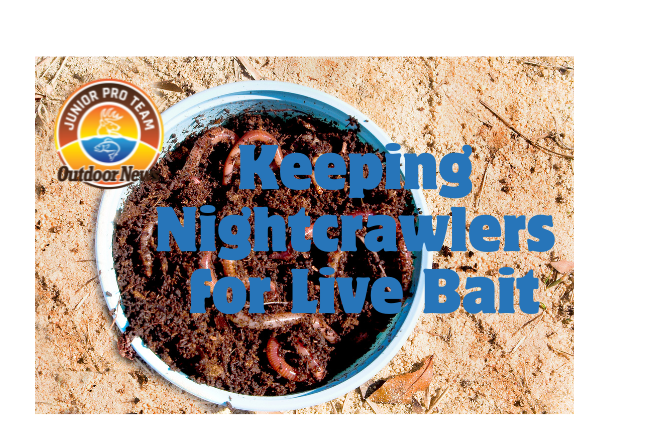This full article by John Tertuliani originally appeared in Outdoor News
 A fat nightcrawler makes for some mighty fine bait. I have yet to find a fish that can
A fat nightcrawler makes for some mighty fine bait. I have yet to find a fish that can
resist a worm presented in a natural manner. Many times, it is true, having a worm on
the hook is all you need, especially when the worm is lively. A wiggling worm can make
a difference. If you’re willing to get some worms and fatten them up, here are some
ideas to help.
Sources
1) You can buy nightcrawlers at bait shop and keep them at home for immediate
access. The author recommends that you open the lid and check to make sure
they are healthy before leaving the store. Store-bought worms are sold in
temporary containers. If you plan to keep them for an extended length of time, it’s
a good idea to put them in a container suited for storing them.
2) Pick them up at night near your home. Nightcrawlers are plentiful in most areas.
Those you buy are usually no better or worse than those you pick up at
night. Picking them up at night is not difficult if you’re willing to go out in the wet
grass on a warm night.
Tips for collecting nightcrawlers:
For a collection container, use a gallon milk jug with the top cut off, leaving the handle
on to carry. One hand is used to hold the light, the other to carry the jug and then grab
worms.
After it has rained or while it’s raining is the easiest time to find them. Wait until an hour
after dark because they need time to crawl out of their burrows. After heavy rain, you
can pick them up on sidewalks and in parking lots before sunrise.
A bright flashlight will send them back down their holes as soon as the light touches
them. Pointing the headlight’s beam away from the worms, instead shining directly at
them, gives you more time to grab.
If you catch one still firmly gripped to its hole, stop pulling; you’ll merely pull it apart. Just
keep a hold of it with a firm grip, and after several seconds the worm will tire and relax
its muscles. Then simply slide it out.
Care of the nightcrawlers
Long-term care requires a stable temperature and clean bedding. An effective
temperature range is 50 to 80 degrees. A refrigerator is ideal for the long term, even if
it’s less than 50. I would rather be below 50 than above 80.
A lid is needed to keep them in their container. If a lid is not used, a light is needed
above the container, turned on at all times. The worms will crawl out of the container
quickly after the light goes off.
Check on them every day or two. Lethargic worms or shriveled worms is a sign of
trouble. Worms should be plump and lively.
Fresh bedding may be needed. The bedding may be OK, but just too dry. A sheet of
newspaper over the bedding serves as a moisture gauge; it should feel damp to the
touch. Too much moisture is just as bad, perhaps worse. Lack of food or poor-quality
food may be the problem, if bedding is fresh and moist.
Feeding
Bedding can provide a source of food as well, depending on how long you want to keep
them. If you want to keep your worms for a week or two, a simple mixture of dirt and
grass or leaves will do. I have used strips of newspaper for bedding and feeding with
sufficient results.
The more worms you want to keep and the longer you want to keep them, the more
serious you should think about checking the bedding each time you check on the
worms.
The best scenario is to buy commercial bedding or make your own from peat moss.
Feeding is necessary when keeping worms for an extended period. Fruit, such banana
peel or apple pieces, are good choices. Citrus fruit, like oranges, should be avoided.

